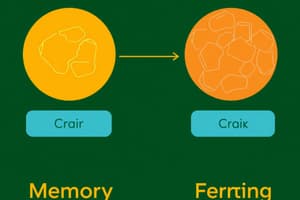Podcast
Questions and Answers
How is the production rule that gains access to the buffer determined in the pattern-matching module?
How is the production rule that gains access to the buffer determined in the pattern-matching module?
- By random selection
- By the least cost of activating the production rule
- By alphabetical order
- By how likely the system is to achieve its current goal if the production rule is activated (correct)
The basic units of declarative memory are called chunks.
The basic units of declarative memory are called chunks.
True (A)
What is the primary cause of Korsakoff's amnesia?
What is the primary cause of Korsakoff's amnesia?
thiamine deficiency (resulting from chronic alcoholism)
Anterograde amnesia is the inability to form lasting memories for new __________.
Anterograde amnesia is the inability to form lasting memories for new __________.
Match the memory disorder with its description:
Match the memory disorder with its description:
Which types of sensory memory are described in the content?
Which types of sensory memory are described in the content?
What is the capacity of short-term memory in terms of items (approximately)?
What is the capacity of short-term memory in terms of items (approximately)?
Sensory memory has a longer duration compared to short-term memory.
Sensory memory has a longer duration compared to short-term memory.
Long-term memory is unlimited in the amount it can store and has _____ time limit.
Long-term memory is unlimited in the amount it can store and has _____ time limit.
Match the following types of long-term memory with their descriptions:
Match the following types of long-term memory with their descriptions:
What is the mechanism through which learning occurs in the brain, involving a long-term increase in the excitability of a neuron to a particular synaptic input?
What is the mechanism through which learning occurs in the brain, involving a long-term increase in the excitability of a neuron to a particular synaptic input?
What structures play particularly important roles in the processing and storing of new explicit memories?
What structures play particularly important roles in the processing and storing of new explicit memories?
Memory consolidation involves the migration of items from the hippocampus to other brain areas for storage.
Memory consolidation involves the migration of items from the hippocampus to other brain areas for storage.
The posterior hippocampus contains __________ cells, neurons involved in spatial navigation.
The posterior hippocampus contains __________ cells, neurons involved in spatial navigation.
Match the following memory structures with their roles:
Match the following memory structures with their roles:
Flashcards are hidden until you start studying
Study Notes
Three-Stage Model of Memory
- The Atkinson-Shiffrin model consists of three stages: sensory memory, short-term/working memory, and long-term memory.
- Sensory memory holds sensory information briefly (1/2 to 4 seconds) and has a large capacity, allowing for selection and processing of information.
- There are two types of sensory memory: iconic (photographic) and echoic (auditory) memory.
Sensory Memory
- Photographic memory, also known as eidetic imagery, is characterized by relatively long-lasting and detailed images of visual scenes.
- Eidetic imagery is relatively rare, occurring in only about 5% of tested schoolchildren and a smaller proportion of adults.
- It is not an especially useful form of mental activity, and memory experts do not generally have eidetic imagery.
Short-Term/Working Memory
- Short-term memory, also referred to as working memory, holds items that are actively being thought about.
- It has a limited capacity (7 +/- 2 items) and is limited in time (5 to 30 seconds).
- Information decays rapidly unless maintained in consciousness through rehearsal.
- Working memory includes a phonological loop, visuospatial sketchpad, and episodic buffer, which are involved in storing and processing verbal and visual information.
Long-Term Memory
- Long-term memory is a repository of all one's knowledge and has an unlimited capacity with no time limit.
- The serial position effect provides evidence for the distinction between short-term and long-term memory.
Types of Long-Term Memory
- Explicit/declarative memory involves conscious recall of information and includes episodic and semantic memory.
- Implicit/non-declarative memory influences behavior or thought without entering consciousness and cannot be verbally transmitted, including procedural memory.
Neurobiology of Memory Processing
- The hippocampus and frontal lobes play important roles in the processing and storing of new explicit memories.
- Long-term potentiation (LTP) is a mechanism through which learning occurs in the brain, increasing the excitability of neurons to particular synaptic inputs.
Memory Disorders
- Dissociation, where brain damage affects two behaviors very differently, suggests that the two behaviors are produced by different processes.
- The hippocampus is central to the formation of explicit memories, and damage to it can lead to anterograde amnesia.
- The cerebellum and basal ganglia are involved in the formatio n of implicit memories.
ACT-R: Hybrid Cognitive Architecture
-
ACT-R is a cognitive architecture with a modular organization that incorporates both symbolic and subsymbolic information processing.
-
It consists of a perceptual-motor layer, cognitive layer, and subsymbolic base, and is designed to operate serially.
-
The symbolic, modular architecture is run on a subsymbolic base, making it a hybrid architecture.### Pattern-Matching Module
-
The pattern-matching module controls which production rule gains access to the buffer by calculating the highest utility at the moment of selection based on the likelihood of achieving the current goal and the cost of activating the production rule.
-
These calculations are subsymbolic and use an artificial neural networks approach.
Declarative Memory
- The basic units of declarative memory are chunks, each associated with a particular activation level.
- The activation level is determined by the chunk's usefulness in the past and its relevance to the current situation and context.
Memory Disorders
- Anterograde amnesia: inability to form lasting memories for new experiences.
- Retrograde amnesia: inability to remember events that occurred before the onset of the condition.
- Organic amnesia: physical cause, such as brain injury through accident or stroke, or Korsakoff's amnesia (Wernicke-Korsakoff syndrome) caused by brain damage resulting from thiamine deficiency, usually due to chronic alcoholism.
- Psychogenic ("hysterical") amnesia: psychological cause, such as dissociative identity disorder (multiple personality disorder), dissociative amnesia, or dissociative fugue.
Alzheimer's Disease
- A disease occurring in the latter part of life, characterized by deterioration of memory, reasoning, and language abilities.
- A common form of neurocognitive disorder, affecting 7% of the population above age 65 and up to 40% of people older than 80 years.
- Associated with loss of neurons in cortical and sub-cortical regions, leading to severe degeneration of large parts of the brain.
- Brains of patients contain many amyloid plaques and neurofibrillary tangles, which contain a core of misfolded b-amyloid protein and twisted filaments of tau protein.
- Deficiencies of acetylcholine, failure to show eyeblink conditioning.
Causes of Alzheimer's
- Genetic component
- Higher risk of disease in those who have previously suffered a stroke or head trauma
- Conditions associated with cardiovascular disease, such as obesity, diabetes, high blood pressure, high cholesterol, smoking, and lack of exercise
- Associated with low levels of vitamin D and certain B vitamins
- Exposure to lead and toxic substances, such as air pollutants, may increase risk
- Hearing loss is now known to be the largest modifiable risk factor for developing dementia.
Research Findings
- Use of anticholinergics is associated with reduced brain volume and lower levels of glucose metabolism, particularly in the hippocampus.
- Anticholinergics include Tylenol PM, Benadryl, Claritin, Dimetapp, Paxil, and Xanax.
- Older people with tooth and gum disease score lower on memory and cognition tests.
- Physically active and non-obese individuals have a lower risk of developing disease.
- Intellectual activity and education seem to protect against Alzheimer's.
90+ Study
- The study found that 40% of participants who were concluded to have Alzheimer's did not have any amyloid plaques or neurofibrillary tangles at death.
- About half of participants who died without symptoms of dementia had plaques and tangles.
- The study suggests that maybe plaques and tangles have nothing to do with Alzheimer's, and that there may be multiple factors that contribute to the development of Alzheimer's.
- The study found that high blood pressure was the factor that most lowered people's risk of getting dementia.
Studying That Suits You
Use AI to generate personalized quizzes and flashcards to suit your learning preferences.




